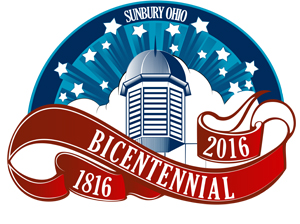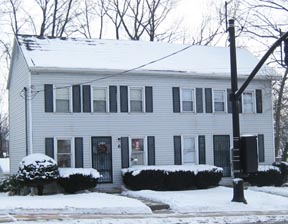| From The Sunbury News, May 19, 2016: |
|
||||
| Because You Asked. . . . | |||||
|
Digging Again |
|||||
|
By Polly Horn, Curator of the Myers Inn Museum |
|||||
 |
Efforts to have a library were begun as
early as 1823 when Lawrence Myers invited people to his home to
start a library on December 25, 1823 by putting a NOTICE which ran
on the front page of the local Spectator. We do not know if
anything came of this effort.
A century later in 1923, State Library of Ohio had a small lending library in the Gelston Bakery next door to the Myers Inn. This operated like a subscription library Young Women's Christian Association |
||||
|
In 1944 Young Woman’s Christian Association, with Marian Whitney as president, held a Tea - Book Shower for all the literary groups. Author Louis Bromfield was to be the guest speaker. Guests were to bring a book. Although Bromfield could not attend, Pearl Whitney presented a paper on Bromfield’s writing and experiments at Malabar Farm. The event netted 200 books and $16 towards a library. Many of Bromfield's books were among the first in the library. Sunbury Council rented space in the basement of the Kempton building at 44 S. Vernon Street for the library. Sunbury Lions Club provided $15 for book shelves and the Y.W.C.A. began collecting books for a community library. Before the library |
|||||
 |
could open, Don Perfect bought the Kempton building and moved the upper two floors to Morning Street just south east of Cherry Street where it | ||||
|
became a
two family house. Perfect built a brick building on the vacant
lot for a garage and salesroom.
This later housed The Sunbury News. |
|
||||
|
White door on left goes into the library. |
Two Family at Morning Street | ||||
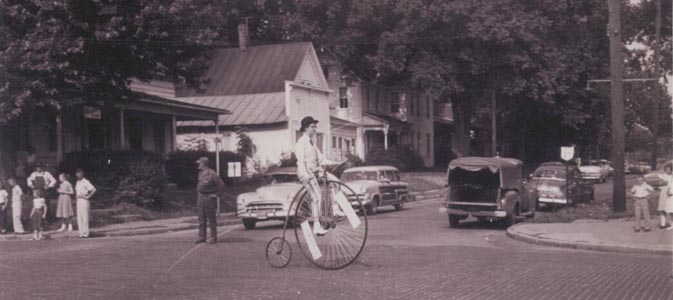 |
Community Library rented the front room in the former meat market at 68 E. Cherry Street. Eventually they had both rooms. Library Page Polly Whitney riding Sunbury News highwheeler in July 4th parade. Library behind her head. |
||||
|
On March 19, 1945,YWCA appointed the first Board of Trustees for Community Library: Rev. M. K. Lashley (1 year), D. C. Hoover (2), Norma Lenhardt (3), V. R. Howard (4), Grace Miller (5), H. P. Irwin (6) and Beatrice Hottle as YWCA representative (7 years). In 1946 the national YWCA adopted an Interracial Charter and Mrs. Hottle felt she could no longer represent the group and resigned. Felice Patton was appointed by Marian Whitney to represent the YWCA. When Joseph McCarthy’s accusations of communism hit the national Y, the local YWCA discontinued to hold meetings and did not continue to hold a seat on the library board of trustees although they did continue to support Y-Teen program in the school. Community Library was led by librarians Magdalene Mahoney in 1944, Mary Kay McCool (later Cockran) in 1946 and Maud Horlocker in 1948. |
|||||
| Photo at right is Story Hour in
the backroom of the library with Mary Kay McCool who later married
Clyde Cochran. Pictured around the table from left front is
Barbara Bullock, Nancy Goff, Beth Perfect, Jackie and Pattie Welch,
Mrs. McCool, Marlene Krohn, Peggy Livingston, Connie Perry, John
Krohn, Roger Stith and Eddie Welch. The empty chairs were Polly and Peg Whitney who were not allowed in any photos which would run in their father's newspaper. |
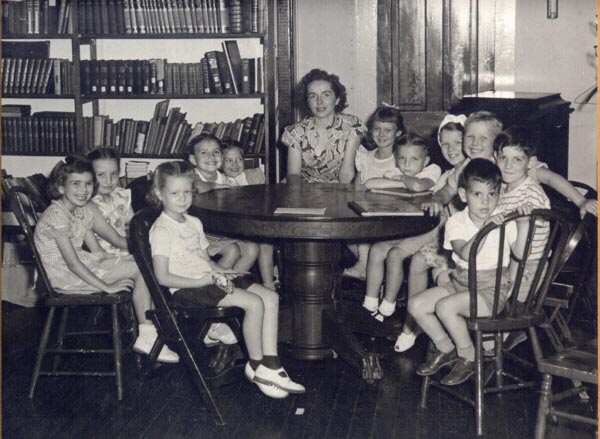 |
||||
|
|
|||||
|
Under Mrs. Burrer, the library outgrew its head-quarters and Sunbury Council removed the jail cell and marshal’s office, added a restroom in the first floor of the Town Hall and rented it to the Community Library. Using a wagon behind D.C. Hoover’s car and children with their wagons, the 8,000 books were moved from Cherry Street into the Town Hall. Growth continued as books were boxed and taken to school classrooms. The local history file and vertical file became my responsibility. In 1966 the library expanded to the second floor. Mrs. Burrer retired in December 1974.
Former pages Rachel Edwards and Polly Horn were hired to split Burrer’s job. Edwards was getting her Library of Science degree from Kent State and became the Library Director.
|
|
||||
|
Open House in the Community Library |
|||||
|
I had been a social group worker with the YWCA (not knowing my mother had helped start the library under the YWCA) and was hired as the Children’s Librarian and in charge of library programming and local history. State Library did not have a summer reading program so I designed one each year. We added training in party ideas for homeroom mothers and monthly field trips for all students k thru 6 to visit the library for book selection and a program. Circulation and book collection grew and the 3rd floor was added to the library. |
|||||
 |
Community Library Friends When the nation celebrated its Bicentennial in
1976, the library became the head-quarters for activities. A
Bicentennial Quilt was made in the library and raffled from income
given to the library by the carnival people who stayed longer that
their original contract. To cash the check, the
Community Library Friends became a the best group of
volunteers any library would ever want. The quilt was won by
Virginia Ihle who did the section on the Dustin Inn in Galena.
The quilt is now in the Burrer Memorial Room in the library. Here they are shown ready to hostess the first Tour of Homes. |
||||
| The first of 10 annual Arts and Crafts Fairs were held on the square in 1975 to get people interested in the upcoming event. | |||||
|
To honor his wife, Mapledell, Harold McMillan bought the Hopkins House an donated it to the library to be used as a place to teach history in a way people will enjoy it. Community Library Friends ran a Thrift Shop in the building while classes and a recreation center for teens. Classes were held as an extension of Columbus State. Howard Cring gave the library land he owned around the back of the Hopkins House and Sunbury Plumbing and Heating on Granville Street. |
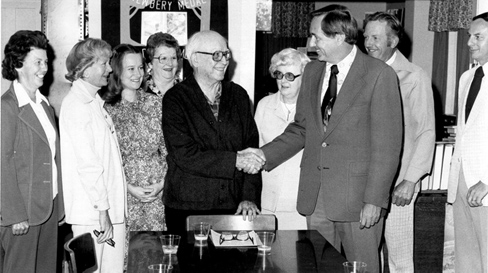 |
||||
|
Harold McMillan giving the Hopkins House to the library in 1978. Genevieve Beaver, Francis Ruthig, Library Director Rachel Edwards, Lolly Searles, McMillan, Mary Lou Beacom, Dick Sechrist, Wayne Reppart and Wendell Davidson. |
|||||
| These additions to the property were thought to one day be the setting for a new library. | |||||
 |
Meanwhile the collection continued to grow. Community Library Friends bought an art collection to circulate. Videos and Nintendo games were very popular. The International Fair brought people from other countries to our square. Then in 1982 some structural changes in the building resulted in the village adding steel I beams to give more support to the facility. The library moved across the street into the former drug store during the renovations. When the project was complete the engineers feared for the safety of the building and asked us not to put books on the third floor. So Edwards rented a former Clark Furniture at Hartford and Walnut Streets to warehouse the extra books. |
||||
|
Dick Sechrist, Frances Ruthig and Howard Cring at the land transfer to Community Library |
|||||
| Once again, patrons would come to the
library and if they could not find the book they wanted they would
complete a form, someone on staff would go to the warehouse several
times a day to retrieve materials and the patrons would return to
pick up the books or magazines. It was time to look for
another facility but there was not a building big enough for the
library purposes. Meanwhile the staff continued to hold events from the store front. The first event was the annual Hanging of the Greens in the store front included an invitation to other merchants to join us for Christmas-on-the-Square the first Saturday night in December. With the Girl Scout Love Feast in the Hopkins House and the library open a new tradition for the town was born. By the following year Mr. Skinner drug a Yule log to the square with his horses and the Boy Scouts joined the festivities and well as several merchants. Community Library Friends served an Oyster and Chili dinner which was followed by Father Christmas, tours of the businesses and the lighting of the Christmas tree and carol singing. The Community Library Board of Trustees began to take steps to
build a new library. Mrs. Edwards left the library and I
became interim librarian while the board searched for a new
director. |
|||||
Because we failed to obtain a clear title on a 10'x15' piece of land in the Hopkins House block, Community Library became the first commercial building on the former Miller Farm. The library was built in almost the same spot the Big Walnut Chamber of Commerce had marked as the Municipal Building in the Greenbelt Plan back in 1975. The library staff continued to get the collection ready for automation by putting barcodes on the videos and issuing patron cards. Then they had to teach the patrons to use them. Volunteers learned to pack boxes of books and code the boxes. |
|
||||
|
Aerial photo taken by Ron Bryant in 1993
showing the cow |
|||||
| What to do with the Hopkins House
became a major problem because there were no funds to keep it up and
meet McMillan's wishes. When the only interested buyers wanted
it for a bed and breakfast and it was gutted, a group decided to
form the Big Walnut Area Historical Society to save it. In
1993 the stagecoach inn was given to the BWAHS for $1 for as long as
they will run a museum in the building. BWAHS changed the name
to Myers Inn after the founder of the town and continued to earn
money and renovate the building until they were able to open it July
4, 2008 at a cost of over $575,500. |
|||||
| On July 4, 1994
a parade of people walked from the old library to the new one over
the bridge built with money donated for the project spearheaded by
the Sunbury Lions Club.
Fifty years after the YWCA dreamed of opening a community library it became a reality. At the left is John Whitney who owned The Sunbury News during the time the dream was becoming a reality, Marian Whitney who had the vision and Polly Horn who saw it to completion. |
|||||
 Trustee President Ben Hart and Former Librarian Dilly Burrer for whom Burrer drive was named, cut the ribbon to open the new library. |
|||||
 |
|||||
| More changes were ahead for the
library. Dvds replaced videos. Computer technology
became more and more complex until Bob Neeper was hired to keep the
computers running. Don and Grace Huddlestun made a $4,000
donation to start the Community Library Foundation which was matched
by his company. Local history collection became very popular
as well as the books individuals wrote for their grandchildren.
Programming of all kinds was well attended, The land south of the library was claimed by right of first refusal. Land west of the library was wanted but I was unable to close the deal. In January 2005, I retired after 30 years of adult employment in the library. In addition to land from Cherry Street to Granville Street and a rainy-day foundation fund of $100,000 the library was well positioned to continue to grow. While I was sad to leave I knew the library and staff were in good hands with Chauncey Montgomery. He had a Library of Science degree, the desire to stay in Sunbury and a love for the library patrons and staff. AND he was able to close the deal on the land I could not get. So now the dirt is moving again at 44 Burrer Drive. The next chapter of the story is Chauncy's to tell. |
|||||
|
. . . . And Now You Know |
|||||
| Return to
Local History Index |
(5/18/2016) |
||||
